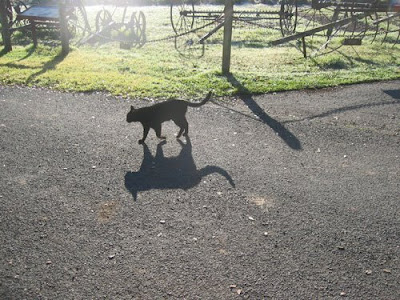In the interest of starting a new year with a clean slate, I offer a correction to yesterday's Spanish Moss. My husband Dick, being from the South, where Spanish moss grows, told me my picture was not of Spanish moss. Master Gardener Katie came to my rescue; it's Usnea, a lichen and an extremely fascinating organism. This is a long excerpt from Wikipedia, but I think it's worth reading.
Per Wikipedia: Usnea is the generic and scientific name for several species of
lichen in the family
Parmeliaceae, that generally grow hanging from tree branches, resembling grey or greenish hair. It is sometimes referred to commonly as Old Man's Beard, Beard Lichen, or Treemoss. Usnea looks very similar to
Spanish moss, so much so that the latter plant's Latin name is derived from it (
Tillandsia usneoides, the 'Usnea-like
Tillandsia').
Usnea grows all over the world. Like other lichens it is a
symbiosis of a
fungus and an
alga. The fungus belongs to the division
Ascomycota, while the alga is a member of the division
Chlorophyta.
Usnea has been used
medicinally for at least 1000 years.
Usnic acid (C18H16O7), a potent
antibiotic and antifungal agent is found in most species. This, combined with the hairlike structure of the lichen, means that Usnea lent itself well to treating surface wounds when sterile gauze and modern antibiotics were unavailable. It is also edible and high in
vitamin C.
Usnea lichen is important to note because it has life-saving potential. Native Americans employed it as a compress to severe battle wounds to prevent infection and gangrene, and it was also taken internally to fight infections. Usnea contains potent antibiotics which can halt infection and are broad spectrum and effective against all gram-positive and tuberculosis bacterial species. Usnea has several unique characteristics which make its identification easy if stranded in the wilderness far from a hospital. Usnea lichens can be easily identified by pulling back the outer sheath on the main stem. Usnea lichens have an elastic pure white cord running through the center of the main stem. Lichen species which resemble Usnea do not have this white cord, and appear grey-green throughout. Usnea lichens do not change color throughout the growing season as do lichen species which closely resemble Usnea.
Usnea also has shown usefulness in the treatment of difficult to treat fish infections in aquariums and ponds; in part due to the Usnic Acid for digestive internal infections or external infections, and as well for gill infections/stress due to Mucilage which is also contained in Usnea.



































